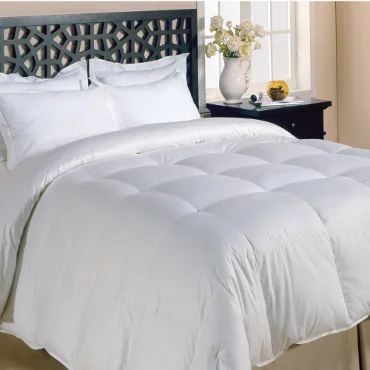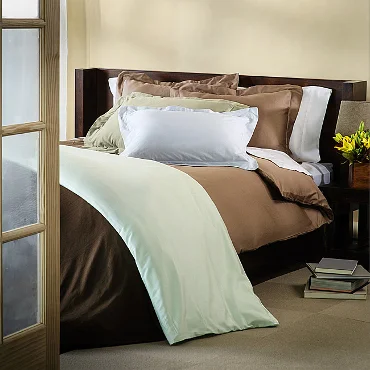Nothing is cozier than curling up under a warm and fluffy down comforter on a cold winter night, but what if natural down isn’t for you? Whether you suffer from allergies or real goose down simply isn’t in your budget, a synthetic down comforter is an excellent alternative to keep you toasty on cold nights. Here are some considerations for finding the best down alternative comforter.
Choosing Between Down or Down Alternatives
The differences between a natural down comforter and a synthetic down comforter boil down to warmth, cost, and aesthetics. Real down is the best choice for the ultimate warmth, however synthetic fiber technology has improved dramatically. Alternative materials now do a much better job recreating the feel of natural down. Synthetic comforters typically have extra fillers to make them warmer. Fillers also add to the weight, making them heavier than their natural down counterparts. Synthetic materials are generally less expensive than real feather down.
Synthetic Fill Materials
The term microfiber refers to extremely fine synthetic fibers. Polyester is one of the more popular synthetics. Polyester is soft, durable, water repellent, and generally less expensive. A hypoallergenic down comforter is a terrific alternative for people who suffer from allergies. Anti-microbial materials are a good choice if you’re concerned with dust mites. Comforters made from gel fibers are lightweight and cushy options that mimic the characteristics of natural down. Wool is another excellent alternative to down. It’s natural, durable, and provides the desired warmth without the extra weight. Wool is naturally resistant to dust, allergens, mold, and mildew.
Warmth
One of the benefits of a heavy comforter is that it allows you to turn the thermostat down at night to conserve energy and utility costs. You’ll want a comforter that’s medium or heavy weight during the coldest winter months. Wearing thick pajamas or using flannel sheets may influence the weight of the blanket you choose. A comforter that’s too heavy may not only be too warm, but can feel smothering or constraining.
Fabric and Thread Count
Cotton, silk, and synthetics are common fabrics used to cover the comforter. They come in thread counts from 100 to upward of 600. Higher thread counts create a softer and more breathable fabric. A thread count between 100 and 200 is the lowest available, and 200 to 300 is considered high quality cotton. Anything over 400 or 500 provides pure luxury.
Size
Shopping for the proper size is important. Obviously you want a comforter that covers the entire bed. In some cases you may prefer the extra warmth or security of one size larger. A queen-size down alternative comforter might be best on a full bed if you and your bed partner tend to play tug-of-war with the covers. Keep in mind that larger sizes are heavier in weight.
Durability, Care, and Cleaning
Durability is a key trait when shopping for the perfect synthetic comforter. Taking proper care of the comforter helps extend its life. If the synthetic comforter is machine washable, use a front-loading machine. Look for a comforter that holds up well through multiple wash cycles. You might consider a down comforter and duvet to reduce the number of times you have to wash the comforter. A duvet is easier to clean, and the comforter can benefit by periodically airing it for freshness. Store your synthetic comforter in a breathable bag during the warmer months when you aren’t using it. Avoid plastic bags which trap moisture and cause mildew to form.
























